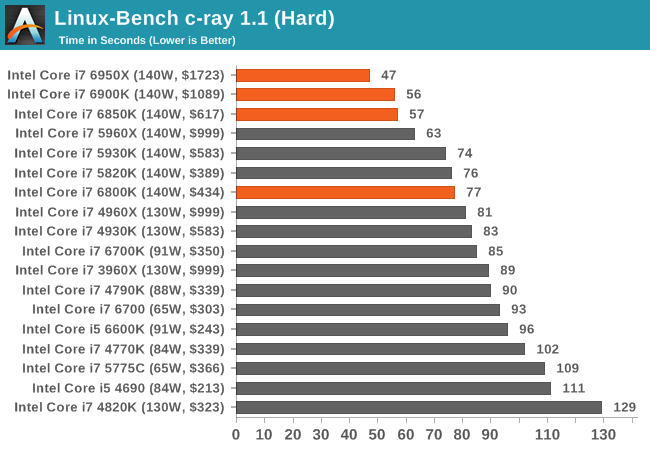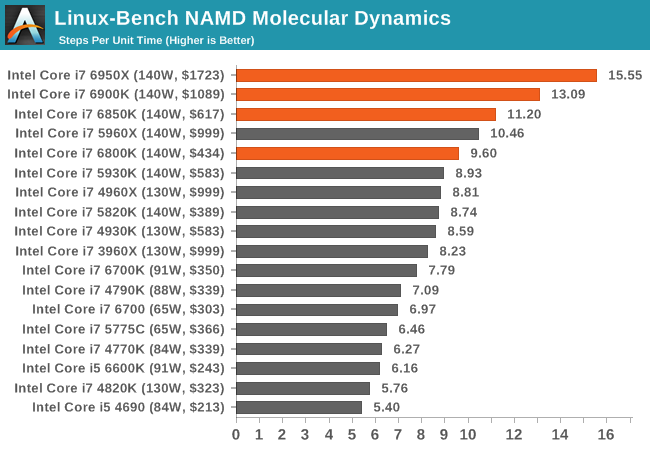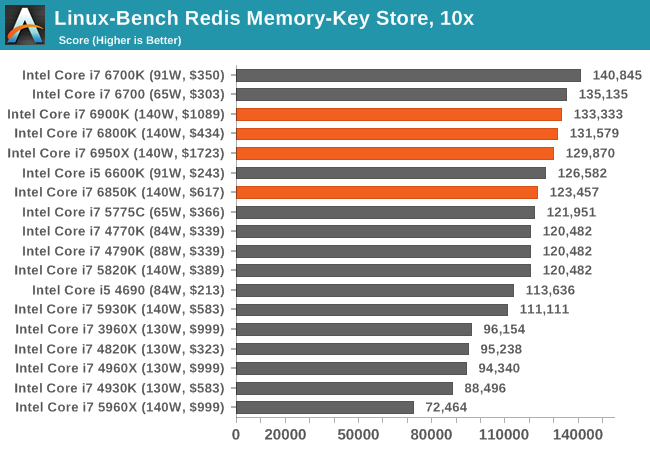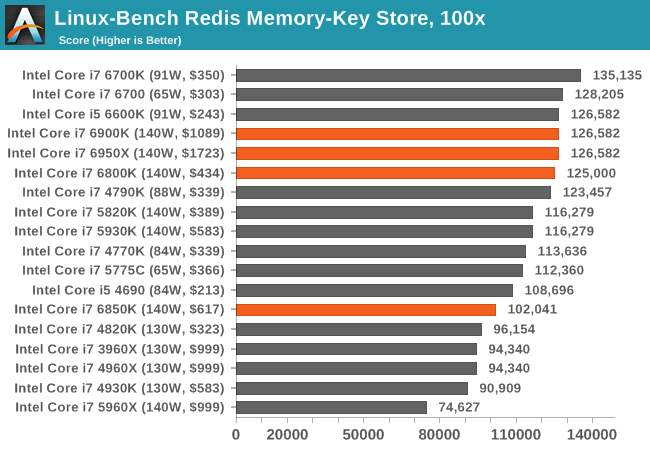The Intel Broadwell-E Review: Core i7-6950X, i7-6900K, i7-6850K and i7-6800K Tested
by Ian Cutress on May 31, 2016 2:01 AM EST- Posted in
- CPUs
- Intel
- Enterprise
- Prosumer
- X99
- 14nm
- Broadwell-E
- HEDT
Linux Performance
Built around several freely available benchmarks for Linux, Linux-Bench is a project spearheaded by Patrick at ServeTheHome to streamline about a dozen of these tests in a single neat package run via a set of three commands using an Ubuntu 11.04 LiveCD. These tests include fluid dynamics used by NASA, ray-tracing, OpenSSL, molecular modeling, and a scalable data structure server for web deployments. We run Linux-Bench and have chosen to report a select few of the tests that rely on CPU and DRAM speed.
C-Ray: link
C-Ray is a simple ray-tracing program that focuses almost exclusively on processor performance rather than DRAM access. The test in Linux-Bench renders a heavy complex scene offering a large scalable scenario.

NAMD, Scalable Molecular Dynamics: link
Developed by the Theoretical and Computational Biophysics Group at the University of Illinois at Urbana-Champaign, NAMD is a set of parallel molecular dynamics codes for extreme parallelization up to and beyond 200,000 cores. The reference paper detailing NAMD has over 4000 citations, and our testing runs a small simulation where the calculation steps per unit time is the output vector.

Redis: link
Many of the online applications rely on key-value caches and data structure servers to operate. Redis is an open-source, scalable web technology with a strong developer base, but also relies heavily on memory bandwidth as well as CPU performance.
[words]












205 Comments
View All Comments
Flunk - Tuesday, May 31, 2016 - link
DX12 actually uses the CPU more efficiently so it should make every LESS CPU constrained, not more so.willis936 - Tuesday, May 31, 2016 - link
Well if you want to toss four channels of memory and 28 pcie lanes out the window and just talk about gaming then you should probably keep it in your head that anyone buying these processors over xeons will be overclocking them. You'll likely get identical single threaded performance on the six core parts to the four core parts but just have 2 more cores. If you say more cores doesn't matter in gaming well idk why everyone (including anandtech) is saying this. I play csgo and bf4 @ 1440p120 on a 770/4790k@4.5GHz and while I'm still GPU limited I see all 8 threads get over 70% usage regularly. I have no doubt that even this 4 core single threaded performance king will bottleneck a 1080 in some cases. Intel has slowed down in performance increases and GPUs haven't. The old talk of "you'll always be CPU limited" shouldn't be treated as dogma. Oh and anandtech should consider changing their CPU gaming benchmarks. It's not super helpful to see a bunch of data that shows a dozen CPUs at a dozen scenarios that are all GPU limited. It's not hard to choose realistic CPU limited scenarios.bogda - Tuesday, May 31, 2016 - link
It is difficult now and it has always been difficult finding meaningful, high end, CPU limited gaming benchmarks (unless you are working in Intel marketing/sales). Nobody buys $1000+ processor to run games at 720p.Anybody thinking about buying high end processor for gaming, after seeing meaningful gaming benchmark, should think twice.
P.S. You probably wanted to say "... you will always be GPU limited should not be treated as dogma".
jacklansley97 - Tuesday, May 31, 2016 - link
These aren't meant for gamers anyway. HEDT has always been aimed at content creation, development, and calculation. I don't know why anyone thinks it's a revelation that these chips don't perform better than a quad core for gaming.Impulses - Tuesday, May 31, 2016 - link
Even then, you need to study your needs carefully... For basic photo/Lightroom tasks clock speed actually matters a decent amount and not a lot of tasks scale super well beyond 4 cores... Obviously for things like video encoding more cores will make a huge difference.joex4444 - Tuesday, May 31, 2016 - link
For gaming, no, but that's the thing: PCs can do so much more than just play games.unityole - Tuesday, May 31, 2016 - link
wanted to see more core per core IPC from 6800/6850k vs 4960x and also 5960x vs 6900k. not just because of technology changed also IPC gain from using TB3.0 which probably minimal.Ian Cutress - Tuesday, May 31, 2016 - link
We covered IPC in both our Broadwell and Skylake mainstream desktop reviews:http://www.anandtech.com/show/9483/intel-skylake-r...
landerf - Tuesday, May 31, 2016 - link
That broadwell has edram. This one doesn't.The two things I and a number of others wanted to see from this review were IPC and overclocking for the whole range, as we've already seen from leaks the 10 core was a bad clocker but a lot of people had high hopes for the lower core models.
Ian Cutress - Tuesday, May 31, 2016 - link
That's a fair point. After Computex blows over I'll look into running Broadwell-E with dual channel memory similar to those tests.